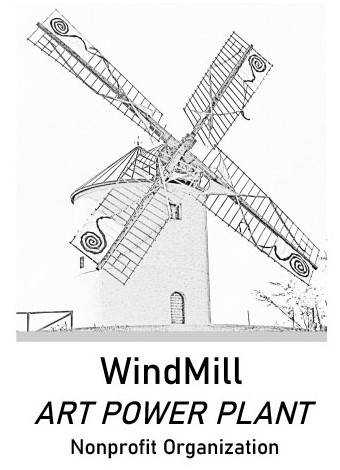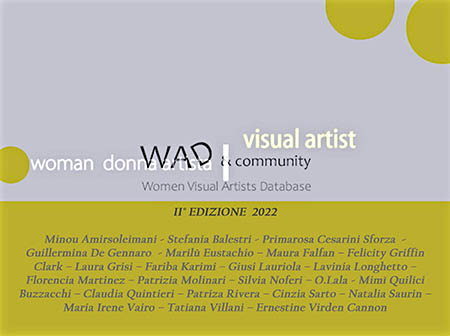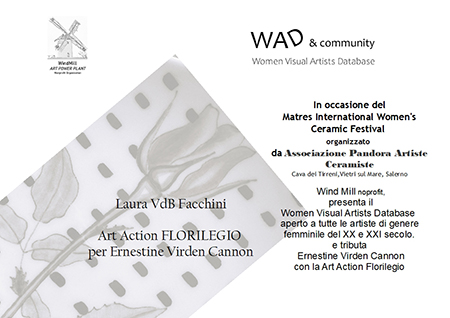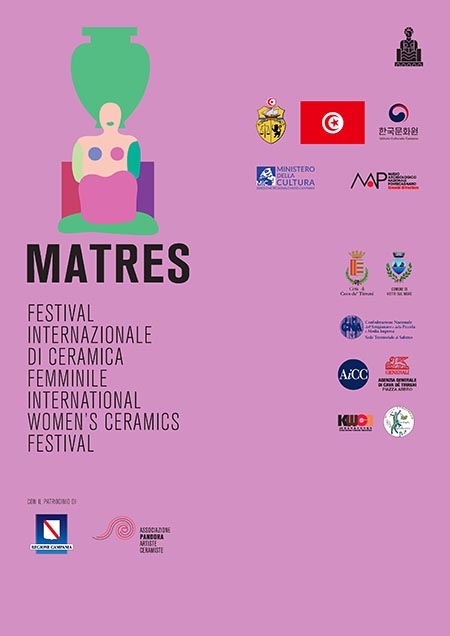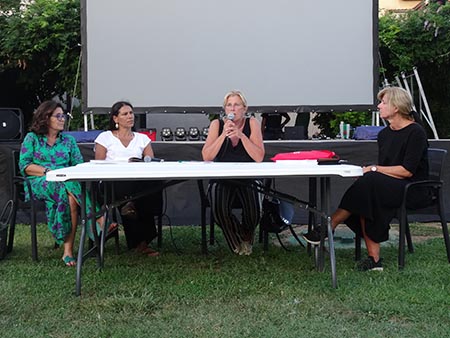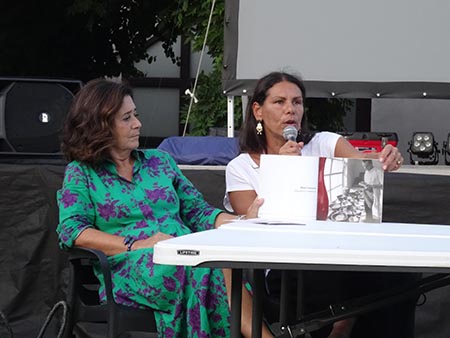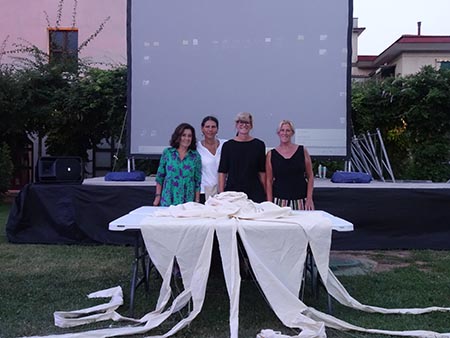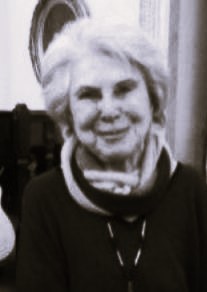2th Edition W.A.D. 2022
Video Ernestine
Art Action Florilegio Ernestine
Maria Grazia Gargiulo – Laura Conforti – Claudia Bonasi – Laura VDB Facchini
Maria Grazia Gargiulo – Laura Conforti
Maria Grazia Gargiulo – Laura Conforti – Claudia Bonasi – Laura VDB Facchini
Franca Zoccoli
Press release translation
On the occasion of the Matres International Women’s Ceramic Festival
Cava dei Tirreni, Vietri sul Mare, Salerno
on August 27, 2022
the WindMill ART POWER PLANT Association
will present the 2nd edition of the Women Visual Artists Database
and the
Art Action FLORILEGIO
for Ernestine Virden Cannon
by Laura VdB Facchini
Women’s art gathers all women into a living artwork
President Anna Rita Fasano of the Pandora Artiste Ceramiste Association,
organizer of the Matres International Women’s Ceramic Festival, inaugurates the
Historical Ceramic Artists section that begins with Ernestine Virden Cannon, with an
exhibition curated by Maria Grazia Gargiulo who also developed her profile for the
Women Visual Artists Database.
SATURDAY 27 AUGUST – SAN GIOVANNI MONUMENTAL COMPLEX GARDEN – GARDEN
DELLE CLARISSE, CAVA DE’ TIRRENI
AT 6:30 PM PRESENTATION BY CLAUDIA BONASI OF THE BOOK BY Maria Grazia Gargiulo
and Laura Conforti: “ERNESTINE CERAMICS. SHAPE, COLOR AND INNOVATION 1948-1968”
AND PRESENTATION OF THE WOMEN VISUAL ARTISTS DATABASE PROJECT
BY Laura VdbFacchini
and Art Action
FLORILEGIO for Ernestine Virden Cannon
The publication of the WOMEN VISUAL ARTISTS DATABASE (2nd edition) will be made visible andavailable online for free on the website www.windmillart.it in the w.a.d.&Community section
The project was launched on March 8, 2021, on the occasion of International Women’s Day, by W.A.D.& Community – Wind Mill nonprofit organization with a never-ending open call aimed at contemporary and twentieth-century visual artists.
Promoted through a social campaign of mobile art action with the video ART IS IN YOUR HANDS (2020), the project involves the construction of a database conceived
as an evolving archive dedicated to the work of international artists.
A non-profit project that combines the two objectives of WindMill: on the one hand the promotion of specific studies by Art Academies and Universities, made possible by cataloging and valorizing the works and biographical profiles of the artists; on the other hand the creation of a community of artists who share the experience of this database as a living organism, intended to encourage exchanges of ideas and collaborations with the aim of placing the complexity of the female artistic experience at the center of the cultural debate in Italy and abroad.
The artists are invited to insert their story into a vision of horizontal art, sharing life and work experiences, so that their example can be a stimulus to the new generations. The artists respond spontaneously to the call, sending a biographical profile together with a selection of images of the works.
Art Historian Franca Zoccoli, wrote the beautiful text Roma com’era for Women Visual Artists Database, remembering the artists,Lilli Romanelli, Franca Sonnino, Gisella Meo, Anna Esposito.
For the 2nd edition of WOMEN VISUAL ARTISTS DATABASE the Scientific Committee, which includes Carolina Ciuti, Manuela De Leonardis, Laura VdB Facchini, Miranda MacPhail, NicolettaRicasoli.
Introducing the artists:
Minou Amirsoleimani – Stefania Balestri – Primarosa Cesarini
Sforza – Guillermina De Gennaro – Marilù Eustachio – Maura
Falfan – Felicity Griffin Clark – Laura Grisi – Fariba Karimi – Giusi
Lauriola – Lavinia Longhetto – Florencia Martinez – Patrizia
Molinari – Silvia Noferi – O.Lala – Mimì Quilici Buzzacchi – Claudia
Quintieri – Patrizia Rivera – Cinzia Sarto – Natalia Saurin – Maria
Irene Vairo – Tatiana Villani – Ernestine Virden Cannon
Rome as it was
in the memories of a nonagenarian
text by Franca Zoccoli
In the 1960s, Rome was a wonderful city, perhaps the most beautiful capital in the world, certainly the richest in history. Having risen from the hardships of war, one could walk on perfect sidewalks, free of weeds along the walls of buildings, along streets with smooth asphalt or, in some places like part of the center, on well-placed cobblestones that formed a smooth surface. Potholes were rare and were quickly repaired: we could admire the grandiose monuments, the prestigious buildings, the famous fountains, without fear of tripping, we could walk in the parks, which make it the greenest city in Europe, sure of finding them well maintained, with regular hedges, trees pruned by expert gardeners, avenues and driveways in order.
It was right, I thought, that Rome should be crossed on the surface and London underground, given the climatic and environmental characteristics of the two cities.
Those were the years of the economic boom and, except for a brief crisis in 1964, called “the conjuncture”, Italy had achieved a widespread well-being never known before. In a certain sense, people still believed in the “magnificent and progressive fates”.
It would be more than half a century before the specter of the corona virus appeared, which was unimaginable just a year ago. Life was relaxed; going downtown in the late afternoon, even without having any particular errands planned, was a pleasure that “the ladies”, and not only them, were reluctant to give up. It should be noted, among other things, that the state-run schedule was from eight to two (including Saturdays) and therefore left many hours free.
Perhaps it is easy after a certain age to become a laudator temporis acti, but it is undeniable that in recent times there has been a spread of vulgarity. Back then the shop windows were glittering but set up with sobriety and good taste, looking at them was a joy even when you could not make purchases. The passers-by were polite and dressed with dignity.
After all, Italians were known for their elegance and distinguished themselves from tourists, even European ones, especially for their shoes. I would like to remind the current exhibitors of nudes, often repulsive, that monkeys lost their hair when they began to wear clothes, thanks to the birth of weaving. In our country in the Sixties, fabrics and styles were the most elegant on a planetary level. It is not for nothing that we have achieved the global success of ‘made in Italy’.
Dogs were rare and, for this reason too, apart from the civility of the owners, you didn’t have to be careful where you put your feet. Generally, you went downtown by public transportation which was reliable and quite frequent. Even petty crime was quite limited. The car was still a privilege and parking downtown wasn’t a big problem.
We often left our cars in Piazza del Popolo, the starting point of the trident streets: Via del Babuino, il Corso and Via Ripetta, along which almost all the most important galleries were located. Closed to traffic for a long time, today the square is undoubtedly much more beautiful, with Valadier’s ingenious architecture fully enjoyable, and yet I miss that gigantic parking lot of my youth.
As in a village at Sunday mass, in that enormous village that was Rome, around 5:30/6, from Tuesday to Saturday, you were sure to meet friends and artists, famous or emerging. There the most daring showed off the first miniskirts, knee-high boots, trapeze dresses with a pendant around the neck.
In the square, around the lion fountain, up to the city walls, without having precise appointments, we wandered among the cars, as in a metal labyrinth, looking for some acquaintance or just for chance encounters. Then we set off to visit the exhibitions, which were mostly stimulating and of a good standard.
Often the inspiration was the opening of a solo or small group exhibition. In such cases, refreshments were always available: not stale peanuts and a poor prosecco, but quality wine, canapés, small pastries, etc. We were rich and it seemed natural to us, we didn’t realize it.
In the same way, it seemed natural to us to walk around calmly even in the evening, without fearing pushes and muggings.
Female artists active in Rome in the last three decades of
the twentieth century
During the last three decades of the last century, cultural life in Rome was very lively, even in the so-called years of lead. A notable contribution was given by artists with the most varied choices of field. Some achieved international fame, such as Mirella Bentivoglio, Maria Lai, Tomaso Binga, Carla Accardi, some received recognition that was not entirely adequate, others were almost forgotten. I would like to recall some of them here, starting with the one that won the first prize of obsolescence:
Lilli Romanelli
After graduating, she painted small figurative paintings for a few years, but achieved her best results during the informal period with large canvases characterized by gestures. “I need space to express myself,” she says. She does not participate in groups and has few relationships with other artists, but she is equipped with antennas that are very sensitive to current events.
She thus tries her hand at new figuration and performance, transforming her body into an aesthetic meaning. Also worth mentioning are her drawings: pen stroke textures, of millimetric, almost prodigious perfection. A veil of pity should be drawn over the “masks” of her last period: old age was not for her. As a person she was funny, nice. She liked to play the part of “artist” and appear extravagant. Once she showed up dressed as an astronaut, another time in a trapeze dress and with an alarm clock around her neck. But in her work she was very serious, meticulous and even capable of undergoing physical fatigue, if she deemed it necessary.She never sold a work, due to a morbid attachment to her works and thanks to the fact that he belonged to a very wealthy family. In this way she carried out a sort of self-cancellation that continues after her death, with her paintings buried in a container due to disagreements between her numerous grandchildren.
Franca Sonnino soon felt the need to work in space and invented something new to create three-dimensional works that did not have the heaviness of marble or bronze. She gradually distanced herself from painting, first by inserting strings and other protruding elements into the painting, then by moving on to weaves, knitted meshes, knotted nets, to finally set up camp in space with vigorous structures always of a textile brand. In this way the artist combines materials and processes that have always been associated with women – thread, weaving – with an architectural vocation that has manifested itself ever more clearly. Starting with an authentic declaration of poetics, the Wall hanging from a nail, a wall under construction, made of perforated bricks, juxtaposed and superimposed, realistically made of brick-colored thread on a metal wire core.
But it is a weightless wall, it can be hung on a nail, because it has all the lightness of fantasy. Sonnino’s works come to completion with an organic growth, knotted stitch after stitch. Like the products of nature, they are never regular or perfectly symmetrical. The result is weightless constructions of surprising modernity. If the comparison with natural data such as spider webs, dried chrysalises or insect shells is spontaneous, the reference to modern experiments in the field of architecture is also necessary.
Gisella Meo is a broad-spectrum artist. A nomad physically on planet Earth, she is also one in art. Born in Treviso (graduated from the Academy of Fine Arts in Venice), after two years spent in Africa and other travels, she moved to Rome in 1970. She remained there for several decades before choosing a more rural town. She began her artistic activity with expressionist paintings, to then be attracted by the gestures of action painting.
From painting she soon moves on to objects: a book that breathes like a living being, cut-out modules that swell in waves, giving dynamism to aseptic geometries. She uses the most diverse materials: paper, plastic, ropes, cement, sheet metal, wood, canvases, but it is the discovery of the “thread” that leads her to her most characteristic repertoire.
Towards the middle of the decade he chooses the external space to create installations and interventions on the territory. Among his most incisive works are “La maglia intorno alla tomba” in Cerveteri and the textile cage around the Torre di Bagnaia, as a sign of peace and homage to the twin towers, a year after the tragic event.
Paradox and irony are the dominant features in Anna Esposito’s work, which deliberately places itself outside of any codified category. The artist uses all sorts of materials, from paper to metal, with two-dimensional or three-dimensional works: the score with notes that become roads, on which bicycles run or people rest on benches; the can of anchovies.
Still in the food field, of particular interest are the “cappelletti” that, falling from a tilted plate, gradually transform into caps, with a reversal that is both physical and semantic at the same time. Still among the first courses, we find the Campbell can that cites the famous Campbell’s Soup Cans by Andy Warhol with references to New Dada and Pop Art USA.
